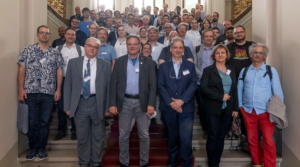The National institute of Nuclear Physics (INFN) is a public Research Institute, supervised by the Italian Ministry for University and Research (MUR). INFN dedicates its experimental and theoretical research to the field of fundamental interactions of Nature, as they are revealed to us in the microscopic domain of nuclei and elementary particles, in the macroscopic domain of high-energy cosmic processes and in gravity. To achieve these goals, researchers at INFN currently develop innovative technologies and make use of them for measurements that are among the most precise ever made by mankind.
Founded in 1951 by groups operating in the Universities of Milan, Padua, Rome and Turin, INFN quickly became one of the leading European Institutes for theoretical, experimental and technological research, also actively pursuing the transfer of knowledge to society, by applying its innovations to medicine, to the cultural heritage and to the environment and by establishing technological collaborations with advanced industries.
INFN exploits an ample autonomy in both management and planning of its scientific research in order to operate at the top of the competitive context of international physical studies. Thanks to its forefront research, INFN quickly grew into one of the most important partners in many international competitive collaborations, establishing a close synergy with the Italian University world.
INFN is actually tied to Universities by consolidated and long-term agreements. The largest part of INFN structures (Sections and connected Groups) operate directly inside the Departments of Physics of Italian Universities. The INFN network also includes four National Laboratories (Frascati, Gran Sasso, Legnaro and South, in Catania), two Centers for Higher Education (the Gran Sasso Science Institute and the Galileo Galilei Institute) and the Trento Institute for Fundamental Physics and Applications (TIFPA). The main structure of INFN also includes a National Research Center in Computational Technologies (CNAF), which coordinates and handles the enormous requirements of the Institute in terms of computation, data analysis and storage.
INFN has settled in Umbria in 1981, thanks to the institution of the connected Group of Perugia. The INFN Section of Perugia was founded in 1989 and hosts all the research lines of the Institute. Over the years, it developed its own specialization in the design, qualification and application of innovative detectors for experimental physics in terrestrial laboratories and in space. The growth of this expertise required the installation of sophisticated laboratories in highly controlled environments (“clean” or “white” rooms), in which the detectors of several major ground-based or space-borne experiments of the last decades were qualified and tested. Among the experiments, we recall the Fermi high-energy space observatory, the Alpha Magnetic Spectrometer (AMS), operating on the International Space Station, the Compact Muon Solenoid (CMS) and the LHCb projects, both at the Large Hadron Collider LHC of CERN, NA62 at the CERN Super Proton Synchrotron, Belle2 at the SuperKEKB accelerator, in Japan, and the interferometer VIRGO, in Cascina, which participated to the exciting discoveries in gravitational wave detection.
The INFN Section of Perugia holds a remarkable position in the Italian and International panorama for its theoretical and experimental studies of particle and astroparticle physics, of nuclear physics and astrophysics, and of gravity. It has also achieved a prominent position in the physical applications to medicine and in the technological transfer to society.










